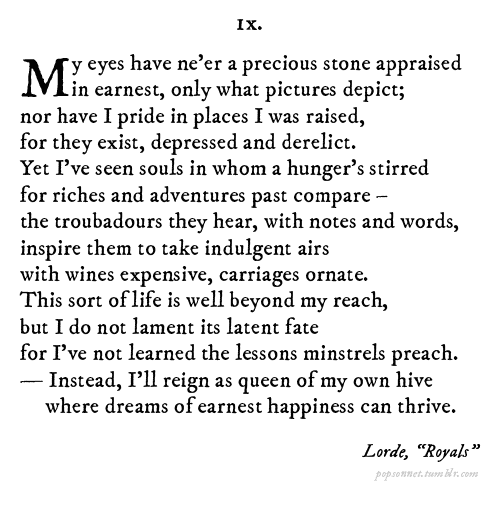Examining Models
PARODY
Erik Didriksen, Pop Sonnet: Royals
What started as a creative challenge turned into a popular Tumblr, where Erik Didriksen put a modern spin on an old poetic form. Didriksen’s study of music helped him recast popular songs as Shakespearean sonnets, in full iambic pentameter. As you read, look for phrases from the original song lyrics reimagined in Shakespeare’s diction.
Source: popsonnet.tumblr.com

Reading the Genre
Question
1. It may seem strange to convert a pop song into an archaic poetic form, but it takes a considerable understanding of both the song and the form. What do you learn about “Royals” from this text? Can you explain the main themes of the song after reading this?
Question
2. Visit the Pop Sonnet Tumblr and look at some other examples of Didriksen’s conversion of pop songs into sonnets. Can you come up with some rules or guidelines for how this conversion is best done?
Question
3. WRITING: Look up the fictional Twitter feed of a famous dead author. Examples include Samuel Johnson, Laura Ingalls Wilder, Flannery O’Connor, and F. Scott Fitzgerald. Then, read or reread some original works by these authors. Comparing these social media quotes with the originals in context, what can we learn? What is lost? Why would someone want to tweet as Flannery O’Connor (or another famous author)? What do you have to know about the author’s style, themes, and biography to select their quotes correctly?
Question
4. CONVERTING POETRY TO SONG: Look up Shakespearean sonnets, and choose one to use for this activity. Read your chosen sonnet closely and identify at least one major theme (love, loss, sorrow). Then, match the sonnet and its theme with a song, and draw some parallels between the sonnet and the song.